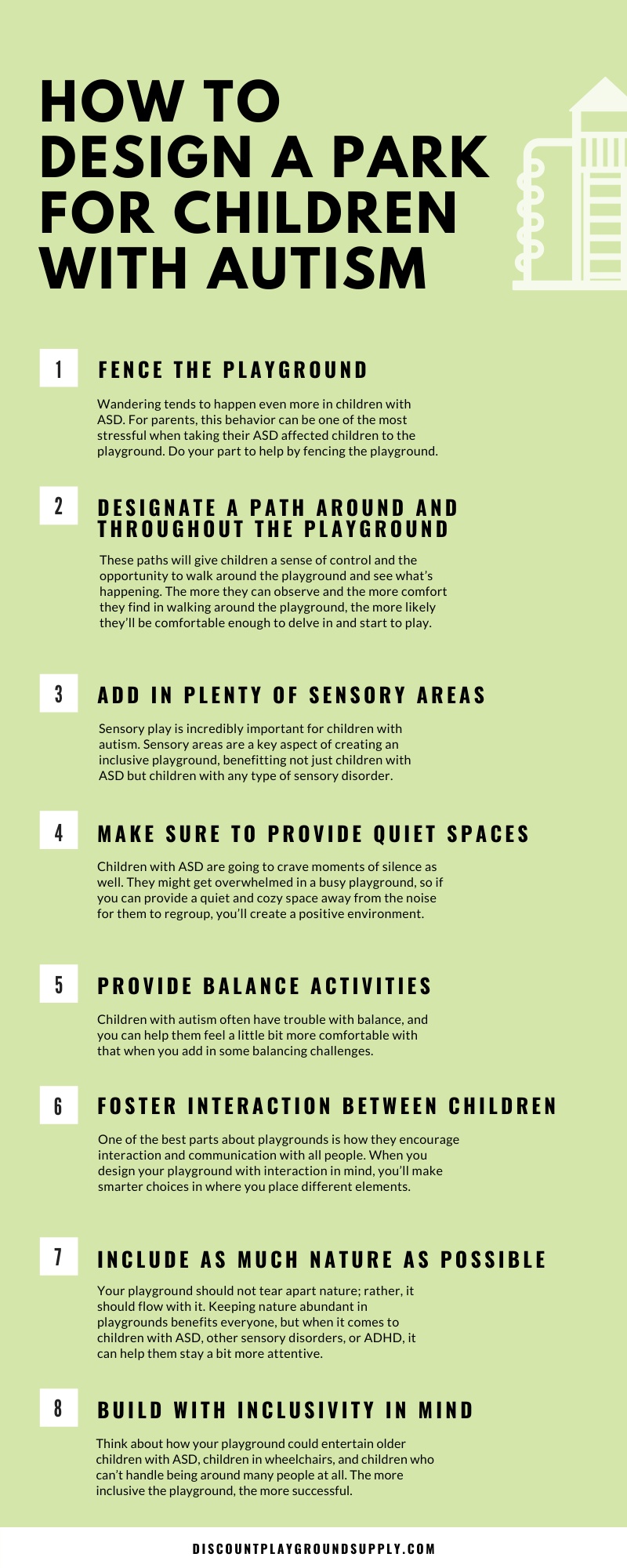
As we talk about quite often, parks are incredible for a myriad of people around the world. They’re great for the development of young children, they’re good exercise for all, and they’re wonderful for providing social moments for seniors. One area that we haven’t fully touched on yet, however, is how amazing parks and playgrounds are for children with autism.
The typical benefits of playgrounds apply doubly for an autistic child. If you want to ensure that your park is accessible and benefits people and children from all walks of life, take a look below. We’ve created a guide on how to design a park for children with autism. Even if you can’t do a complete redesign, you can at least add in some of these elements to expand your park and playground’s audience!
Fence the Playground
Wandering tends to happen even more in children with ASD. According to the American Journal of Psychiatry, children with ASD attempt to elope from a safe environment at a rate nearly four times higher than their unaffected siblings. For parents, this behavior can be one of the most stressful when taking their ASD affected children to the playground. Do your part to help by fencing the playground. This will play a huge role in easing overwhelm for parents and children.
Designate a Path Around and Throughout the Playground
Similarly, since children with autism are more prone to wandering, the more paths you designate around the playground, the better. These paths will give children a sense of control and the opportunity to walk around the playground and see what’s happening. The more they can observe and the more comfort they find in walking around the playground, the more likely they’ll be comfortable enough to delve in and start to play. These paths can be the difference between a child sticking to the entrance or delving in and sparking their creativity.
Add in Plenty of Sensory Areas
Sensory play is incredibly important for children with autism. Sensory areas are a key aspect of creating an inclusive playground, benefitting not just children with ASD but children with any type of sensory disorder. Include chances for kids to use their tactile, auditory, and visual systems by adding in a variety of activities and play areas. Mix textures, sounds, and colorful things to look at. Things like musical instruments, play panels, and more will provide a safe space for when they get overwhelmed with the play of the playground. Our playset activity panels are a great start to adding sensory elements to your playground.
Make Sure to Provide Quiet Spaces
Yes, we did just say to add auditory sensory elements, but that doesn’t mean that you should fill the entire playground with it. Children with ASD are going to crave moments of silence as well. They might get overwhelmed in a busy playground, so if you can provide a quiet and cozy space away from the noise for them to regroup, you’ll create a positive environment. This may include a little tunnel away from the rest or little hangout spaces for them to relax.
Provide Balance Activities
Another area that you should think about building into your playground design are balance activities. Children with autism often have trouble with balance, and you can help them feel a little bit more comfortable with that when you add in some balancing challenges. Combine static balance activities with dynamic balance activities. For example, find and encourage a balance area for when people are sitting and one for when children are in movement, like a plush balance beam. This is a small thing to add that can end up helping a variety of children.
Foster Interaction Between Children
One of the best parts about playgrounds is how they encourage interaction and communication with all people. Children talk to each other regardless of race, socio-economic background, ability, or gender. They just love to play. When you design your playground with interaction in mind, you’ll make smarter choices in where you place different elements. For example, if you only have two swings, or one slide with not enough space for a line, or if you put the sensory and wheelchair friendly elements so far away that they can’t play with the other children, then your playground won’t act as a bridge between children. There’s more to playground design than figuring out how big the slide should be.
Include as Much Nature as Possible
Your playground should not tear apart nature; rather, it should flow with it. Keeping nature abundant in playgrounds benefits everyone, but when it comes to children with ASD, other sensory disorders, or ADHD, it can help them stay a bit more attentive. For example, those paths that we talked about above can wander through flower beds and plant-filled walkways. Gardens, grassy areas, trees—all these things can calm children down and help them feel more centered before they run off to play more.
Build With Inclusivity in Mind
Long story short, when you think about building and designing with people of various backgrounds in mind, you’ll have a much more successful playground. Think about how your playground could entertain older children with ASD, children in wheelchairs, and children who can’t handle being around many people at all. The more inclusive the playground, the more successful. You’ll expand your outreach to those outside of the “norm” and provide a safe space for everyone. It’s something that everyone can enjoy.
These are just a few of the many ways that you can build and design a playground for children with autism in mind. Even if your playground is already built, if you can find a way to bring in some of these elements, you’ll provide a safe place for many children and their families. When we consider the needs of children with disabilities at the beginning of the design process, then the playground will be enjoyed by everyone in the community!
For all your playground needs, turn to Discount Playground Supply. From rubber playground borders to provide a more distinct separation between areas to playset activity panels, we want to make sure that everyone feels welcome at your park and playground. Partner with Discount Playground Supply, and we can help you feel more confident in your playground design plans—reach out now!


